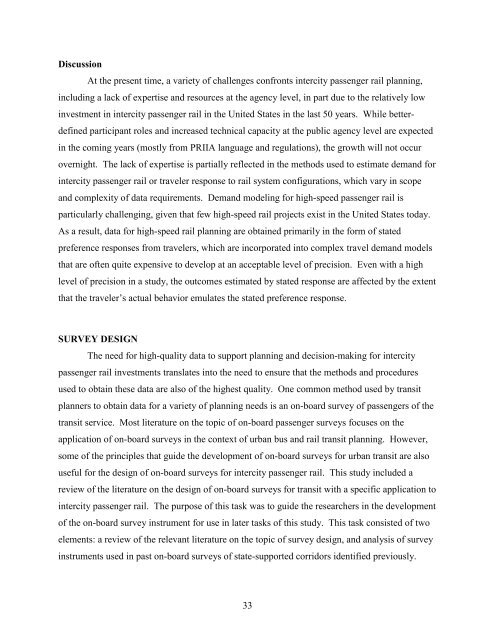Measuring the Benefits of Intercity Passenger Rail: A Study
Measuring the Benefits of Intercity Passenger Rail: A Study
Measuring the Benefits of Intercity Passenger Rail: A Study
Create successful ePaper yourself
Turn your PDF publications into a flip-book with our unique Google optimized e-Paper software.
Discussion<br />
At <strong>the</strong> present time, a variety <strong>of</strong> challenges confronts intercity passenger rail planning,<br />
including a lack <strong>of</strong> expertise and resources at <strong>the</strong> agency level, in part due to <strong>the</strong> relatively low<br />
investment in intercity passenger rail in <strong>the</strong> United States in <strong>the</strong> last 50 years. While betterdefined<br />
participant roles and increased technical capacity at <strong>the</strong> public agency level are expected<br />
in <strong>the</strong> coming years (mostly from PRIIA language and regulations), <strong>the</strong> growth will not occur<br />
overnight. The lack <strong>of</strong> expertise is partially reflected in <strong>the</strong> methods used to estimate demand for<br />
intercity passenger rail or traveler response to rail system configurations, which vary in scope<br />
and complexity <strong>of</strong> data requirements. Demand modeling for high-speed passenger rail is<br />
particularly challenging, given that few high-speed rail projects exist in <strong>the</strong> United States today.<br />
As a result, data for high-speed rail planning are obtained primarily in <strong>the</strong> form <strong>of</strong> stated<br />
preference responses from travelers, which are incorporated into complex travel demand models<br />
that are <strong>of</strong>ten quite expensive to develop at an acceptable level <strong>of</strong> precision. Even with a high<br />
level <strong>of</strong> precision in a study, <strong>the</strong> outcomes estimated by stated response are affected by <strong>the</strong> extent<br />
that <strong>the</strong> traveler’s actual behavior emulates <strong>the</strong> stated preference response.<br />
SURVEY DESIGN<br />
The need for high-quality data to support planning and decision-making for intercity<br />
passenger rail investments translates into <strong>the</strong> need to ensure that <strong>the</strong> methods and procedures<br />
used to obtain <strong>the</strong>se data are also <strong>of</strong> <strong>the</strong> highest quality. One common method used by transit<br />
planners to obtain data for a variety <strong>of</strong> planning needs is an on-board survey <strong>of</strong> passengers <strong>of</strong> <strong>the</strong><br />
transit service. Most literature on <strong>the</strong> topic <strong>of</strong> on-board passenger surveys focuses on <strong>the</strong><br />
application <strong>of</strong> on-board surveys in <strong>the</strong> context <strong>of</strong> urban bus and rail transit planning. However,<br />
some <strong>of</strong> <strong>the</strong> principles that guide <strong>the</strong> development <strong>of</strong> on-board surveys for urban transit are also<br />
useful for <strong>the</strong> design <strong>of</strong> on-board surveys for intercity passenger rail. This study included a<br />
review <strong>of</strong> <strong>the</strong> literature on <strong>the</strong> design <strong>of</strong> on-board surveys for transit with a specific application to<br />
intercity passenger rail. The purpose <strong>of</strong> this task was to guide <strong>the</strong> researchers in <strong>the</strong> development<br />
<strong>of</strong> <strong>the</strong> on-board survey instrument for use in later tasks <strong>of</strong> this study. This task consisted <strong>of</strong> two<br />
elements: a review <strong>of</strong> <strong>the</strong> relevant literature on <strong>the</strong> topic <strong>of</strong> survey design, and analysis <strong>of</strong> survey<br />
instruments used in past on-board surveys <strong>of</strong> state-supported corridors identified previously.<br />
33
















